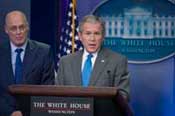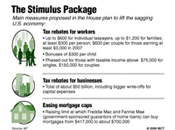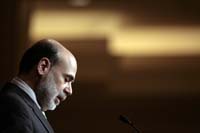 RT photo illustration
RT photo illustration
Article
The intensifying American banking crisis threatens the stability of its economy and the world’s. Where is it leading?
Learn the why behind the headlines.
Subscribe to the Real Truth for FREE news and analysis.
Subscribe NowGlobal financial stability has been shaken and America is facing a growing economic crisis that could make the 1930s look like “good times.” The U.S. banking system is on the verge of disaster, as banks have recorded over $100 billion in losses, with hundreds of billions more forecasted.
Simply put, America’s banks are staring into a financial abyss.
What started with subprime mortgage losses in 2007 is now growing into a full-blown financial crisis. Consider just one example. As of January 2008, Stockton, Calif. (pop. 280,000), had 4,200 homes in default or foreclosure, with bad loans totaling a staggering $1.4 billion. According to CBS News, Stockton has gone from being one of the hottest real estate markets to the foreclosure capital of America. Prices of homes in the city have dropped as much as 70%.
In many of the nation’s cities, towns and smaller communities, Stockton-like scenarios are playing out. Banks are busy auctioning off houses at “fire sale” prices.
And the news keeps growing worse. Once proud banking titans Merrill Lynch and Citigroup had to look to investments from Asian and Middle Eastern governments (through “Sovereign-Wealth Funds”) to shore up their balance sheets. They were rescued by life-saving injections of $6.6 billion and $14.5 billion, respectively. European banks have also been affected, as Swiss, German, French and British banks have suffered billions of dollars in losses.
The losses are not confined to banks alone. One of the world’s largest insurance companies, American International Group, recently reported losses from the mortgage crisis of up to $5 billion—up from a previous estimate of $2 billion. This may be a sign of coming reassessments by others as the crisis intensifies.
At a meeting of the G7 finance leaders, German Finance Minister Peer Steinbrueck stated that the G7 feared losses from the subprime mortgages could reach as high as $400 billion (nearly as large as the entire economy of Holland, ranked 16th worldwide). Highlighting the gravity of the economic situation, U.S. Treasury Secretary Hank Paulson described it as “challenging and uncertain.”
A deadly combination of the credit crunch, the collapsing housing market, increasing energy prices, and the threat of rising inflation are rapidly weakening America’s economy.
The crisis threatens to engulf banks and other financial institutions, affecting pension funds, mutual funds and insurance companies. The situation is so grave that President George W. Bush and the Federal Reserve (the Fed) have implemented unprecedented emergency measures, including stimulus plans, tax rebates and interest rate freezes, in an effort to prevent total collapse. The stability of the global economy is at stake.
Traditional vs. Modern Banking
Banks traditionally operated by taking deposits from their customers and lending money to those seeking loans. The difference between the interest rate paid on deposits and the higher one charged on loans (the “spread”) was their profit. If customers defaulted on their loans, banks were liable to depositors for payment—the banks held the risk “on the books,” 100% their responsibility. It was therefore in a bank’s best interest to carefully screen customers’ ability to repay before providing loans. The customer needed to have a good job, adequate assets, and was required to make a sizable down-payment. This conservative approach to lending enabled banks to make tidy profits for decades, while staying financially sound.
 MCT
MCT

However, the 1990s saw banks change their traditional way of operating. Seeking higher and higher profits to satisfy shareholders and to secure executive performance-pay bonuses, banks decided they could make even higher profits if they loaned out more money. To do this, they used other people’s money through “securitization,” a process that allows banks to convert hundreds, even thousands, of mortgages into bonds and then sell the bonds to investors, such as pension funds, mutual funds, insurance companies and other banks. Banks did not make a profit through the “spread” anymore, but instead made a fee for having put together (“originated”) the loan, now owned by other investors.
Further, the bonds were insured by specialized insurance companies (so-called “monoline” insurers), and were rated as safe investments by the rating agencies (i.e., Standard & Poor’s, Moody’s, and Fitch).
Since the loans were now “off the books” and insured, the banks felt comfortable about “originating” even more loans. Through their new fee-based income, banks made much higher profits than ever before.
Reckless Lending
In their quest for higher profits, banks no longer felt the need to carefully screen loan applicants, as they once did. Customers who did not qualify for loans under the banks’ standard lending procedures (i.e., “subprime” customers) were now targeted as a lucrative source of income, and marketed aggressively to. Loans were provided to people with no income, no job and no assets (so-called NINJA loans).
Additional “sweetener” incentives were also provided, such as no down payment required and interest-only payments. Those who initiated the loans and approved them were no longer attached to the risk, and were paid handsomely for their efforts.
The subprime mortgage market became a ticking bomb, ready to explode at any time.
Enter the Fed
 MCT
MCT
Two developments have played a significant role in the development of modern banking and the current crisis.
The first was deregulation of the U.S. financial services industry with the 1999 repeal of the Glass-Steagall Act, after years of lobbying by the banks. Carefully crafted during the Great Depression to control speculation in the stock market, Glass-Steagall prevented retail banks, insurance companies and investment banks from owning each other. With the repeal of Glass-Steagall, massive financial services conglomerates were suddenly formed, combining these three types of financial institutions. Industry behemoths such as Citigroup and JP Morgan quickly came into being. This meant that retail banks seeking higher and higher profits could now dive headlong into high-risk speculative ventures through ownership of (or being owned by) investment banks, which led to disastrous consequences during the Stock Market Crash of 1929.
The second was the low interest rate policy pursued by the Federal Reserve. Low interest rates encouraged banks to target subprime customers with variable rate mortgages. Banks offered initially low interest rates (“teaser” rates), to be increased two or three years later. Because of rising house prices, customers took the bait believing they could refinance their homes at an affordable rate when the time for the reset arrived.
A Culture of Greed
In many cases, mortgage brokers misrepresented terms and conditions to eager customers who provided them with fraudulent information. Sometimes banks did not even bother to check the information provided. “Predatory lending” was compounded by “predatory borrowing”!
Banks sold risky bonds as safe investments to unsuspecting investors. Rating agencies, paid by the banks, rated risky bonds (those with subprime components) as safe—even giving them the highest rating.
With substantial increases in real estate prices occurring every year, builders went on a building spree around the nation.
This created a sense of “easy money”—“something for nothing.” In their greed, many were “scamming the system.” At a meeting in Toronto, Canada, billionaire investor Warren Buffet commented, “It’s sort of a little poetic justice, in that the people that brewed this toxic Kool-Aid found themselves drinking a lot of it in the end” (Reuters).
Crisis Strikes
The crisis started in the summer of 2007. Due to the surplus of homes on the market, housing prices fell moderately—tipping the scales. Also around this time, the first batch of interest rate resets came due. Faced with exploding monthly payments, falling house prices, and an inability to refinance their mortgages, many customers defaulted on their loans. Lenders call it “jingle mail,” as so many homeowners are just turning in their keys.
Confronted with higher monthly payments on mortgages that are greater than the value of their homes, homeowners are abandoning their mortgages. Many feel no moral obligation to fulfill what they promised to repay, believing it is better to walk away from their homes. They feel that while this hurts their credit rating, in the short-term it hurts less than the downward spiral toward bankruptcy.
This change in attitude is in stark contrast to years ago when borrowers felt a moral duty to pay off their loans. With the morals and values of the nation disintegrating, many lack the character and fiscal responsibility of previous generations.
An American City at the Edge of Bankruptcy
Vallejo, Calif., is deep in a financial crisis. Years of overspending have left the city, as City Councilwoman Stephanie Gomes called it, “teetering on the edge of bankruptcy” (Associated Press). The city, population 126,000, faces an immediate $10 million general fund cash shortage and almost a $13.8 million deficit for the next fiscal year. Vallejo may soon run out of funds.
Mayor Osby Davis downplayed the option of bankruptcy, refusing to call it the only possibility and promising to look to other solutions. “I like to look on the positive side,” Mr. Davis told local television station NBC11.
“I’m confident we’re going to be able to work this out without having to file bankruptcy. It’s not an alternative we want the public to believe we’re moving toward with any intention.”
The City Council has drawn up an emergency plan that would cut $20 million from the current budget, with most cuts coming from city-funded jobs. The emergency plan includes cutting city salaries 5% by June 30, 2008, reducing firefighter and police officer salaries by 15%, and electrical worker funding by 8%. Overall, 17% of general funds positions would be cut, requiring layoffs.
However, the spending cuts must be approved by unions of these groups. Current labor pacts are in force until 2010, meaning the unions are not legally required to negotiate.
Contracts for public safety jobs such as police officers and firefighters make up 80% of the city’s general fund budget.
Similar cuts have been proposed before to ebb Vallejo’s overspending but have always been voted against by the unions.
Though there are many causes of the city’s financial problems, the fire department proves to be a prime example of the budgeting troubles. During the past years, the fire department has suffered from staff shortages, forcing many firefighters to work overtime, with some making $100,000, or even $200,000, a year. Further, upon hearing the city was in dire financial straits, more than 14 fire employees retired, meaning Vallejo must spend an additional $4 million in buyout costs.
Vallejo’s current liability for already earned retiree benefits of retired and active city employees is $135 million, with another $6 million being accrued per year.
“It’s not a question of whether it is right or wrong for employees to give up anything. This is totally a question of survival of the city,” said Councilwoman Joanne Shivley (Times-Herald).
Being the first city in California to declare Chapter 9 bankruptcy means there is no template or previous case to predict what this would do to the city.
City Manager Joseph Tanner said in a report to the City Council that without a compromise with the unions, his estimate for insolvency was late April 2008.
The city now waits for the decision of four main unions or it will quickly run out of options. Councilwoman Shivley told NBC11 that the cuts being “purposed in order to remain solvent will decimate city services.” She continued, “Anything other than totally new contracts is a Band-Aid.”
Crisis Spreads
As the crisis intensifies, mortgage defaults are multiplying. And everyone is on the hook. “Monoline” insurance companies have suddenly become liable for multiple billions of dollars of debt. Investors have been left holding bonds that may never be repaid. Banks are finding it difficult to sell additional bonds as investors have backed out of the market, leery of poor investments. Thus, the banks’ fee income has dried up—leaving them with massive deficiencies in capital.
As credit problems mount, banks have sharply reduced lending to each other and the public, fearful the loans will not be repaid (the “credit crunch”).
Shockwaves from the crisis are also being felt in other sectors of the economy. Evidence of this is clear, as liquidity dries up and less money is available to finance commercial loans. Recently, a group of bankers were unable to back $14 billion of debt to finance an entertainment company. Other major deals in the tens of billions are now in jeopardy. Deutsche Bank had to repossess some Manhattan buildings because a well-known developer was unable to refinance $7 billion of debt. The credit crunch has pushed beyond retail banking; it is now affecting major business deals and even commercial real estate. And municipal bonds (used to fund cities, colleges and hospitals), which were once considered safe investments, can no longer readily find buyers.
As more and more loans arrive at interest rate resets, more defaults will occur, deepening the crisis. A financial tsunami is rapidly approaching America’s shores!
Kings Become Beggars
Increasingly, America’s banks have been forced to look to other nations for capital. Recently, U.S. banks received massive infusions of capital from Asian and Middle Eastern sources that are purchasing larger stakes in America’s largest bank institutions.
During the G7 meeting mentioned earlier, Toshihiko Fukui, governor of the Bank of Japan, made a statement that could have serious ramifications, as the banking crisis further deteriorates: “If everyone does the same thing it won’t be any more effective. Each country needs to do what is best for its own particular situation.”
In the near future, will countries that have so often supported America financially stop doing so, causing the crisis to spiral out of control?
Recent news spotlighted a trend in New York that was unimaginable just a few years ago: Some shops are now accepting Euros for payment of merchandise. While accepting foreign currency has been the norm along the Canadian and Mexican border, accepting it in the financial capital of the world is a sign of a weakening U.S. economy. This distrust of American capital is just the tip of the iceberg, as people and nations are learning there are alternatives to the U.S. for security and investment.
Time will tell if the ongoing financial irresponsibility of America will cause the world “to do what is best for its own particular situation.” If this happens, it will hasten the demise of the U.S. as the world’s financial leader. There are indications that this has already begun. In its Jan. 15 issue, the Financial Times noted, “The U.S. looks poised to lose its mantle as the world’s dominant financial market because of a rapid rise in the depth and maturity of markets in Europe, a study suggests. The change may have occurred already, not least because the U.S. markets are beset by credit woes, according to research by McKinsey Global Institute.”
The American banking crisis shows the vulnerability of the global economic system. The world is looking for an alternate, and America will be replaced as the financial engine of the world by a superpower soon to arise in Europe.
The good news is that a new—and far superior!—global economy will one day be established. Instead of being rooted in greed and corruption, this future worldwide financial system—which will benefit every nation, small and great—will be based on outgoing concern for others. From individuals to businesses to government bodies, all will practice fiscal responsibility during the soon-coming age the Bible refers to as “the world to come” (Matt. 12:32; Mark 10:30).
Until then, there are financial laws and principles found in God’s Word that—if faithfully lived by—would bring a multitude of benefits here and now, in this current age.
If you would like to learn more, read our booklet End All Your Financial Worries.



